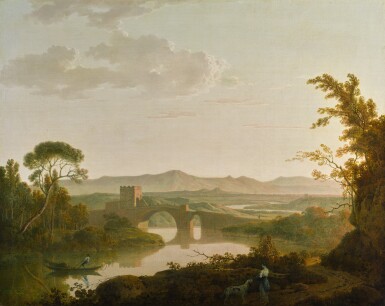
The Property of Leighton House Museum, Kensington | 肯辛頓萊頓故居博物館收藏
JOSEPH WRIGHT OF DERBY, A.R.A. | An Italian river landscape with a bridge and tower at sunset, with figures in the foreground | 約瑟夫・懷特・德比,A.R.A. | 《意大利河景,黃昏下的橋與塔樓,前景見人物》
Auction Closed
December 4, 08:03 PM GMT
Estimate
100,000 - 150,000 GBP
Lot Details
Description
The Property of Leighton House Museum, Kensington
肯辛頓萊頓故居博物館收藏
JOSEPH WRIGHT OF DERBY, A.R.A.
約瑟夫・懷特・德比,A.R.A.
Derby 1734-1797
1734-1797年,德比
An Italian river landscape with a bridge and tower at sunset, with figures in the foreground
《意大利河景,黃昏下的橋與塔樓,前景見人物》
signed and dated centre right: I.W.P. / 1785
and bears further signature and date lower right: I.W. / 1785
款識:藝術家簽名並紀年I.W.P. / 1785(右中),另附簽名並紀年I.W. / 1785(右下)
oil on canvas
油彩畫布
76.5 x 96 cm.; 30 1/8. x 37¾in.
76.5 x 96公分;30 ⅛. x 37 ¾英寸
Sir Claude Phillips (1846–1924);
Presented by his executors to the Royal Borough of Kensington in 1925, and later transferred to Leighton House Museum.
On long term loan to Tate Britain, London, 1986 to 2012.
B. Nicholson, Joseph Wright of Derby. Painter of Light, London 1968, vol. I, p. 260, no. 291, vol. II, p. 160, reproduced pl. 250.
Joseph Wright of Derby spent nearly two years travelling in Italy. Having left England in November 1773, Wright arrived in Rome in February 1773 and remained there until September that year. In October and November he visited Naples, exploring Pompeii and Herculaneum, as well as the wonders of the Amalfi coast, but was back in Rome by the end of the year, staying until June 1775. The Eternal City and the surrounding countryside were a revelation to the artist and he was overwhelmed by the antiquities of the city itself. Writing to his brother in May 1774 he enthused about ‘the amazing and stupendous remains of antiquity’ and all the ‘fine things this country [Italy] abounds with... the artist finds here whatever may facilitate and improve his studies’.1
Hitherto landscape had played only a very small part in Wright’s art but in Italy, with the warmth and serenity of the south upon him, his attitude to landscape changed dramatically. As Nicholson poetically put it ‘Alexander Cozens replaces Rosa in his heart’ and he became captivated by ‘Roman ruins with picturesque shrubbery growing like tufts of unkempt hair out of their decaying arches’.2 He sketched heavily, making more drawings during his time in Italy than he had ever done before, and on his return to England seized every opportunity he had to paint landscapes; writing to a friend in 1792 'I know not how it is, tho' I am engaged in portraits... I find myself continually stealing off, and getting to Landscapes'. This picture, which is dated 1785, is a masterpiece of the artist’s late maturity and captures the more serene and meditative approach that Wright had adopted in his landscape art by this period, in which form almost dissolves into light.
1 J. Ingamells, A Dictionary of British and Irish Travelers in Italy 1701–1800, New Haven and London 1997, pp. 1023–24.
2 Nicholson 1968, p. 75.
